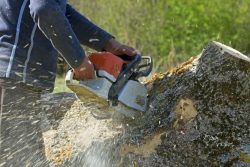 Chainsaws are one of the most powerful tools you can buy, some moving at speeds of more than 50 miles per hour. Of course, that also makes them extremely dangerous. Proper safety precautions are essential for operating a chainsaw or any other kind of Husqvarna forest care tool, and beginners should strongly consider taking a safety training course to master the basics before purchasing tools of their own.
Chainsaws are one of the most powerful tools you can buy, some moving at speeds of more than 50 miles per hour. Of course, that also makes them extremely dangerous. Proper safety precautions are essential for operating a chainsaw or any other kind of Husqvarna forest care tool, and beginners should strongly consider taking a safety training course to master the basics before purchasing tools of their own.
That said, chainsaws also have many practical uses around the house, especially if that house is surrounded by trees. They can be used for maintenance and landscaping, which can add to your curb appeal and increase your home’s resale value by 14%. Or they can be used to collect wood to fuel an outdoor wood burning furnace during the colder months. Whatever your reasons, here are a few basic safety tips and reminders for using a chainsaw.
- Features: Get to know your chainsaw’s built-in safety features, which may vary by make and model. All Husqvarna forest care chainsaws come with an inertia-activated chain brake, which will automatically stop the chain if it’s kicked upwards. Many types also come with bumper spikes, hand guards, chain catchers, throttle lockout, and spark arresters.
- Gear: In addition to the chainsaw itself, you’ll want the appropriate protective gear: A helmet, with an eye visor and hearing protection; gloves; protective pants or chaps; and anti-slip boots.
- Cutting: Carefully prepare the direction for felling a tree. Most will have a natural direction they’ll want to fall, but if surrounding structures make it so that you have to force it in another direction, you’ll want additional felling support tools.
- Common Sense: Never operate a chainsaw without someone nearby or knowing where you are in case of an accident. Never park a vehicle beneath the area you’re cutting. Never try to operate a chainsaw with only one hand. These bits of advice may sound obvious, but they’re routine causes for serious injuries every year.
While this safety checklist is by no means exhaustive, it should give you a better sense of how to prepare for proper chainsaw use. The best way to learn more is by taking a course — or letting the professionals handle the work for you.